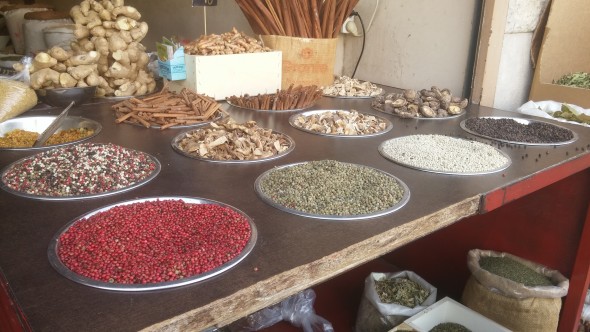Chef and food writer, Yehudah Jacobs, walks us through the 10 Middle Eastern spices every American mouth should fall in love with now.
There are a lot of spices out there, but as any good chef will tell you, it’s about quality and balance versus throwing tons of random flavors into the fire. Middle Eastern spices are exceptional when it comes to delivering crisp, precise flavor notes that can turn the taste volume up for vegetables, grains, fish, and meat.
Here are the 10 best Middle Eastern spices that’ll make you want to hop on a camel or magic carpet to your local outdoor market:
- Sumac. Sumac comes from the sumac bush which produces small, red berries. To create the actual spice the berry is dried and ground up, leaving a grainy, deep red powdery substance. An interesting spice with a lemony finish, sumac will brighten up any protein and is traditionally served on top of of kebab and grilled meats. Sprinkle it on right before eating.
2. Za’atar. Za’atar, pronounced zah-ah-tahr, it’s certainly one of the most interesting spice blends. It starts out with a couple of fresh herbs including oregano, basil, thyme, thyme, and stureja (which is from the rosemary family). All of these spices are found in the Middle East naturally, so it’s a sort of curry of the north. The entire blend is dried, ground, and mixed with sesame seeds, sumac and salt. Sprinkle it anywhere you’d add a dash of olive oil, like hummus, on crispy bread, salad, or cheese dishes.
3. Cardamom. Cardamom is a beautifully aromatic spice. It comes in two colors– black and green, and it’s also one of the world’s most expensive spices after saffron and vanilla. Both green and black have different uses. The black pod has a smokier and more bitter aroma with a hint of mint. The green pod s used for its seeds and used because of its sweet finish that you might recognize from desserts and tea blends. When buying cardamom, keep the spice pods in tact until you’re ready to use– otherwise they lose their flavor and aroma. Green pods are used often in tea and coffee, black pods are good in curry, meat dishes and fish.
4. Moroccan paprika. Moroccan paprika is paprika on steroids! The paprika comes from Hungary (you know, the normal stuff you find in plastic bottles at your local supermarket) and then when it reaches Moroccan spice vendors they mix in olive oil, sea salt and chopped garlic. It’s a gourmet, artsy paprika that will enhance your dishes and give your cooking game anther win. It’s a perfect addition to slow-cooked dishes, meat balls, or just about anything with tomato sauce.
5. Ras el hanout. Ras el hanout is a lively, bright spice blend that’s commonly used for just about every protein at a BBQ. It’s one of North Africa’s favorite blends, and a definitely popular choice amongst the best Middle Eastern spices out there. It was actually created in North Africa and is made from a blend of 12 spices ground together like cardamom, cumin, clove, nutmeg, mace and lots more. Secret tip: try grilling tofu and sprinkling this on. YUM.
READ MORE: 10 Foods Trends from Israel to Watch in 2016
6. Baharat. Another type of spice blend, baharat is used widely around the gulf states. Countries including Turkey, Israel, Lebanon, Jordan and more are all obsessed with amping up their locally caught fish with this special blend. It’s made from different spices in different ratios than ras el hanout but the concept is the same. The main difference when compared to ras el hanout is the smokey finish.
7. Cumin. Cumin is a very versatile spice that comes from the parsley family. Not only is it used in Middle Eastern cuisine it’s also great in Tex-Mex, Latin, and Carib cooking as well. The flavor profile is very strong, with a bit of bitterness on the finish. Cumin works very well within spice blends as well. Try adding it to your vegetarian soups for an earthy flavor, or to any stew with chicken.
8. Turmeric. Turmeric is the ginger-family spice that makes dishes go yellow, and often your clothes, too. Thanks to the very mild flavor when used in small portions, turmeric is a natural food coloring in a spice form. It’s perfect when added to any natural fat (like olive oil) in a pan before frying just about anything because the flavor mildly enhances just about anything savory, and is one of the healthiest spices around. It’s also been called ‘the poor man’s saffron’ because it’s cheap, easy, and gives everything it touches a bright golden color.
9. Saffron. Saffron is the opulent king of Middle Eastern spices and ounce for ounce the most expensive spice in the world. Saffron has a very distinctive use in cooking by giving dishes a golden, reddish brown finish. What saffron adds in flavor to a dish is a bit of warm tanginess and a slight bitterness, depending on the strain. It’s best used to color rice and other grain dishes, stews, and oven baked chicken.
10. Coriander Seeds. Coriander is a very special type of spice offering because it comes in a both a plant form and a fruit form. The herbal plant form is great for putting in anything that you want to give a Middle Eastern kick to, like kebabs or grilled fish. The seeds are a whole different story, and they are used in a different manor. Either use in a pepper mill and ground over fresh dishes or in stews even in pickling spices, they’re versatile, earthy, nutty, tangy, and just delicious. Make the seeds the cornerstone of your pickling mix, a subtle addition to your stew, or a small component in savory waffles.












You say za’atar is a mix of spices – yet the photo shows a sack of ‘alei za’atar’ = za’atar leaves.